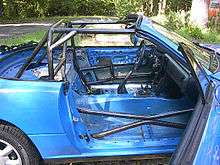Spec Miata


Spec Miata is a class of racing car used in Sports Car Club of America (SCCA), National Auto Sport Association (NASA), and Midwestern Council of Sports Car Clubs (MCSCC) road racing events.
The Spec Miata (SM) class is intended to provide the opportunity to compete in low-cost cars with limited modifications, suitable for racing competition. It is intended to encourage low cost, entry level, production car based competition. Spec Miata currently races both sprints and enduros where available.
Mazda MX-5s (also known as Mazda Miata Roadsters) in model years 1990 through 1993 with 1600 cc engines, model years 1994 through 1997 with 1800 cc engines, and model years 1999 through 2005 with 1800 cc engines have been approved by the SCCA for Regional racing in all divisions of the SCCA. The class was approved for National SCCA racing beginning in the 2006 racing season. At the professional level, the SM cars are known as the MX-5 Cup.
The first Spec Miata race was held in February 2000 by the NorCal Region of the National Auto Sport Association.[1] At the national level, the "UPR Racing Supply First Ever Spec Miata National" was held in Avondale, Arizona at Phoenix International Raceway's infield road course on April 4th 2005 with Brad Rampelberg as the "First Ever" National race winner. Results of the 1st SCCA National Qualifying Race may be googled at: azscca 2006 National Double Double. Mike Helpin a local highly respected racer was awarded the 1st place trophy because Brad Rampelberg was disqualified for an undisclosed reason. Brads disqualification was later overturned by a SCCA board. Brad Rampelberg was named winner in later posted results. (may be seen at the above azscca website) As its name shows, Spec Miata is a "specified" class. This means that the rules for allowable modifications to the car are very strict. The class intends to put drivers on a very even footing by making their cars as identical as possible. The rules are far more conservative than the Improved Touring category, but provide equivalent safety measures.
Because of the support of Mazda through Mazdaspeed, the wide availability of the car on the used market, plentiful and inexpensive parts, and the simplicity of maintenance on the cars, Spec Miata has become a very popular class. Also adding to the appeal is the fact that A Spec Miata can be raced in both SM and ITA/ITS in SCCA Regional Competition. A typical race-ready spec miata can be purchased on the market for $8000–$35,000 depending on race win history and specific modifications. A new MX-5 Cup (professional class) based on the ND series MX-5 costs $58,900 new, and champions of the national series can win over $200,000 to advance up the motorsport ladder.
Class rules
This section is not an exhaustive set of rules; it is intended to give the reader an idea of the preparation level of the cars in this class.

Spec Miatas use a specific Bilstein shock with an adjustable coil-over suspension with Eibach springs and adjustable front and rear sway bars, steel braided brake lines.
Depending on the region, Toyo, Kumho, or Hankook tires are specified. For National competition, the Toyo RA-1 (205/50R15) is the spec tire. Toyo RA-1 is now required in SCCA as of January 1, 2010 though the R-888 may be used until supplies are exhausted. In 2012 Hoosier Tires[2] will provide the spec tire for all National Events. The wheel size is fixed at 15x7, with the wheels weighing no less than 13 pounds.
Cars with 1.6 liter engines have a race weight of 2300 pounds (1057 kg) and first generation cars with a 1.8 liter displacement engine have a minimum race weight of 2350 pounds. "Second generation Miatas" (1999-05) have a minimum weight of 2400 pounds. (These rules as of January 1, 2012)
The 1.8 liter displacement cars may not run an aftermarket air intake and must run a throttle restrictor, while the 1.6 liter displacement cars do not require a restrictor and may run a modified air box. The full rules for the class may be found in the current Spec Miata Category Specifications of the SCCA rule book, called the GCR (General Competition Rules & Specifications).[3]
SCCA National Champions
- 2017 Preston Pardus, New Smyrna Beach, Florida
- 2016 Justin Hille, Ypsilanti, Michigan
- 2015 Johnathan Goring, Norfolk, CT from Alfas Unlimited Racing
- 2014 Erik Stearns, Van Buren, OH from East Street Racing
- 2013 Jim Drago, Memphis, TN from East Street Racing
- 2012 Jim Drago, Memphis, TN From East Street Racing
- 2011 Elivan Goulart, Shelton, CT
- 2010 Andrew Charbonneau, Delray Beach, FL[4]
- 2009 Steven Gorriaran, Providence, R.I.
- 2008 Eric Foss, Northeast Oklahoma Region
- 2007 Brad Rampelberg, San Francisco Region
- 2006 Andrew Caddell, Northwest Region
NASA National Champions
- 2017 Michael Ross *East / *2017 Tristan Littlehale *West
- 2016 Tyler Kicera *East / *2016 Nick Sommers *West
- 2015 Mark Drennan *East / *2015 Mark Drennan *West
- 2014 Alex Bolanos
- 2013 Matt Schultz
- 2012 Yiannis Tsiounis
- 2011 Nathanial Sparks
- 2010 Dan Mackeever
- 2009 Andy Rushing
- 2008 Todd Lamb
- 2007 Todd Lamb
- 2006 Greg Stasiowski
References
- ↑ Baruth, Jack (May 2015). "Spec-Tacular". Road & Track. 66 (8): 60.
- ↑ racer.com. "Hoosier named tire for SCCA National Spec Miata competition beginning in 2012". racer.com. Retrieved 19 August 2011.
- ↑ "Archived copy". Archived from the original on 2010-02-21. Retrieved 2010-02-19.
- ↑ "Charbonneau Takes Caution-Filled Spec Miata SCCA National Championship". scca.com. Archived from the original on 22 December 2010. Retrieved 19 August 2011.
General Competition Rules and Specifications, 2006, Sports Car Club of America.
External links
- Sports Car Club of America
- Spec Miata Challenge from the National Auto Sport Association
- Mazda Racers - Official Spec Miata and Mazda racing community
- Spec RX-7 - Spec Miata alternative